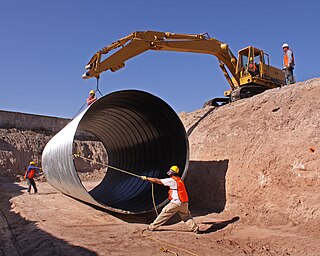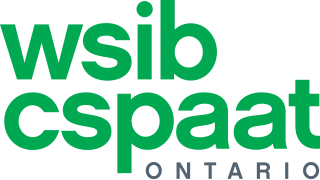The Occupational Safety and Health Administration is a regulatory agency of the United States Department of Labor that originally had federal visitorial powers to inspect and examine workplaces. The United States Congress established the agency under the Occupational Safety and Health Act, which President Richard M. Nixon signed into law on December 29, 1970. OSHA's mission is to "assure safe and healthy working conditions for working men and women by setting and enforcing standards and by providing training, outreach, education, and assistance." The agency is also charged with enforcing a variety of whistleblower statutes and regulations. OSHA's workplace safety inspections have been shown to reduce injury rates and injury costs without adverse effects on employment, sales, credit ratings, or firm survival.

Workers' compensation or workers' comp is a form of insurance providing wage replacement and medical benefits to employees injured in the course of employment in exchange for mandatory relinquishment of the employee's right to sue his or her employer for the tort of negligence. The trade-off between assured, limited coverage and lack of recourse outside the worker compensation system is known as "the compensation bargain.” One of the problems that the compensation bargain solved is the problem of employers becoming insolvent as a result of high damage awards. The system of collective liability was created to prevent that and thus to ensure security of compensation to the workers.

A safety data sheet (SDS), material safety data sheet (MSDS), or product safety data sheet (PSDS) is a document that lists information relating to occupational safety and health for the use of various substances and products. SDSs are a widely used type of fact sheet used to catalogue information on chemical species including chemical compounds and chemical mixtures. SDS information may include instructions for the safe use and potential hazards associated with a particular material or product, along with spill-handling procedures. The older MSDS formats could vary from source to source within a country depending on national requirements; however, the newer SDS format is internationally standardized.

The Occupational Safety and Health Act of 1970 is a US labor law governing the federal law of occupational health and safety in the private sector and federal government in the United States. It was enacted by Congress in 1970 and was signed by President Richard Nixon on December 29, 1970. Its main goal is to ensure that employers provide employees with an environment free from recognized hazards, such as exposure to toxic chemicals, excessive noise levels, mechanical dangers, heat or cold stress, or unsanitary conditions. The Act created the Occupational Safety and Health Administration (OSHA) and the National Institute for Occupational Safety and Health (NIOSH).
The Michigan Occupational Safety and Health Administration (MIOSHA) is a state government agency that regulates workplace safety and health in the U.S. state of Michigan. Michigan OSHA is an agency within the Michigan Department of Licensing and Regulatory Affairs, and operates under a formal state-plan agreement with the Occupational Safety and Health Administration (OSHA).

The Health and Safety at Work etc. Act 1974 is an act of the Parliament of the United Kingdom that as of 2011 defines the fundamental structure and authority for the encouragement, regulation and enforcement of workplace health, safety and welfare within the United Kingdom.

The Workplace Safety and Insurance Board (WSIB) is the workplace compensation board for provincially regulated workplaces in Ontario. As an agency of the Ontario government, the WSIB operates "at arm's length" from the Ministry of Labour, Training and Skills Development and is solely funded by employer premiums, administration fees, and investment revenue. The WSIB is one of the largest compensation boards in North America and is primarily responsible for administering and enforcing the Ontario Workplace Safety and Insurance Act (WSIA).

The Control of Substances Hazardous to Health Regulations 2002 is a United Kingdom Statutory Instrument which states general requirements imposed on employers to protect employees and other persons from the hazards of substances used at work by risk assessment, control of exposure, health surveillance and incident planning. There are also duties on employees to take care of their own exposure to hazardous substances and prohibitions on the import of certain substances into the European Economic Area. The regulations reenacted, with amendments, the Control of Substances Hazardous to Work Regulations 1999 and implement several European Union directives.
Right to know is a human right enshrined in law in several countries. UNESCO defines it as the right for people to "participate in an informed way in decisions that affect them, while also holding governments and others accountable". It pursues universal access to information as essential foundation of inclusive knowledge societies. It is often defined in the context of the right for people to know about their potential exposure to environmental conditions or substances that may cause illness or injury, but it can also refer more generally to freedom of information or informed consent.
North American Occupational Safety and Health (NAOSH) Week is an annual celebration that happens during the first full week of May. The aim of the event is to raise awareness about occupational safety, health, and the environment (OSH&E) in order to avoid workplace injuries and illnesses.
In common with most of Europe and North America, Australian State Parliaments have responded to workplace illness, injury, and death by enacting legislation regulating workplace hazards. Until the 1970s and 80s, these standards were generally detailed and technical, focusing mainly on prescriptive measures such as specifying machinery guarding measures to be adopted to prevent injury to workers operating dangerous machinery. Beginning in 2008, state and federal regulations were harmonised, giving greater clarity and consistency in the legislation in effect in the various states.
The WorkCover Authority of New South Wales was a New South Wales Government agency established in 1989. The agency created regulations to promote productive, healthy and safe workplaces for workers and employers in New South Wales. The agency formed part of the Safety, Return to Work and Support Division established pursuant to the Safety, Return to Work and Support Board Act, 2012 (NSW).
An occupational fatality is a death that occurs while a person is at work or performing work related tasks. Occupational fatalities are also commonly called "occupational deaths" or "work-related deaths/fatalities" and can occur in any industry or occupation.
The Workers' Compensation Board of British Columbia, operating as WorkSafeBC, is a statutory agency that was made in 1917, after the provincial legislature put into force legislation passed in 1902. This legislation is known as the Workers Compensation Act.
A lone worker (LW) is an employee who performs an activity that is carried out in isolation from other workers without close or direct supervision. Such staff may be exposed to risk because there is no-one to assist them and so a risk assessment may be required. Lone workers are now often supported by cloud-based automated monitoring systems and specialised monitoring call centres - often referred to as an 'Alarm Receiving Centre' or 'ARC' in the UK, or 'Emergency Dispatch Center' or 'EDC' in the US.

The Occupational Health and Safety Act 2000 is a repealed statute of New South Wales (NSW). The Act was repealed by the Work Health and Safety Act 2011.

Occupational safety and health (OSH) or occupational health and safety (OHS) is a multidisciplinary field concerned with the safety, health, and welfare of people at work. OSH is related to the fields of occupational medicine and occupational hygiene and aligns with workplace health promotion initiatives. OSH also protects all the general public who may be affected by the occupational environment.
The Occupational Health and Safety (OHS) Regulation of British Columbia is the primary source of law governing workplace health and safety, which was most recently amended in 2016. It sets the standard to which workplaces must attain when inspected by WorkSafeBC, unless they are exempt from inspection, e.g. mines.
The law for workplace bullying is given below for each country in detail. Further European countries with concrete antibullying legislation are Belgium, France, and The Netherlands.
Tanzania has a number of laws and regulations that govern occupational safety and health (OSH) protections for workers. The International Labour Organization reports that due to insufficient statistics and consistent reporting, it is impossible to determine the number of workplace accidents that occur in the country.







